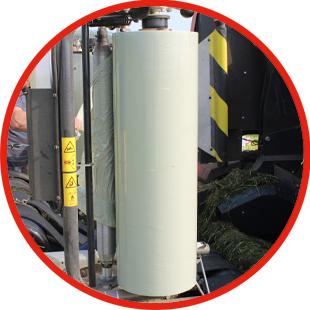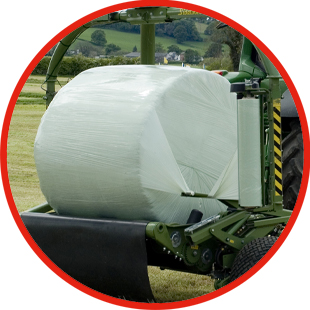
After months of non-use, it is advisable to test your baler before heading into baling.
A straw or hay bale can be used to gauge the film application.
Balewrap should be stretched at 55-70% with 50% overlap over each layer. Check all moving parts are free-moving and monitor oil levels.

When it comes to producing good quality, nutritious silage, small things can make a big difference. Ensuring that your machine is set up correctly will help things go smoother and opting for a good quality silage wrap will ensure that your efforts aren’t wasted due to inadequate protection.
For the best balewrapping results, take consideration to the points below both before and during silage season…
1. Regularly clean down the PSU rollers using a degreaser and wire brush to remove any build-up of tack and dirt. This is essential to maintain consistent and even stretching of the film onto the bale.
2. Align the film with centre of bale for correct film overlap.
3. Routinely check film neck-down & overlap on the bales. Correctly stretched film should neck down to between 580 - 620mm on the bales. If the film is aligned correctly with the centre of the bale, a 50% film overlap should measure half of the film neckdown width.

4. Calibrate and set the number of turns required to achieve the recommended number of film layers. To do so, count the number of turns it takes to completely cover the baled crop, add one extra, and triple this number to apply the recommended 6 layers of film (2+2+2).
5. Randomly select and check a bale for film layers. Do this by removing a large square section (300mm x 300mm) of applied film from the centre of the bale (not from the end) and separate the individual layers using sticky tape.
6. Check that PSU springs have sufficient resistance to apply consistent pressure between the film roll and break roller.
7. Check that correct film stretch levels are being achieved by placing two marks 10cm apart on the film roll. After stretching onto the bale, this should measure 17cm for the recommended 70% stretch on round bales (if using 55% gears film should measure 15.5cm).

8. Routinely check, and if necessary, replace cutting blades on the cut and tie system. If blunt or incorrectly aligned, the film will not cut cleanly and could lead to loose tails on the bale.
9. Check belts, rollers and bobbins are not damaged and free moving. Damaged PSU rollers can cause film to tear, break and create holes. Worn out or damaged belts & bobbins can lead to incorrect application and damage to film. Repair and replace if necessary.
10. Always follow machine manufacturer recommendations for maintenance and software updates.

Bertrand Ooms, Silotite’s sales manager for Belgium, the Netherlands and Northern France, explains important points to consider when selecting a silage balewrap.
“A good quality balewrap requires an equal balance of cling capacity, puncture resistance, tear resistance, elongation and tightening force. Too much, or too little of any of these features will offset the performance of the film and cause problems in either the wrapping process or storage life.
Silotite’s Pro films utilise patented Pro Technology and are manufactured on the latest 7- and 9-layer lines. Pro technology, allows for a lightweight film, while maintaining mechanical strength and oxygen barrier profiles. It also creates a more stable production process, exhibiting fewer variations in thickness to ensure uniformity throughout the roll, resulting in fewer breakages and less downtime. SilotitePro’s 1800m length enables farmers and contractors to wrap more bales per reel, which results in reduced downtime and increased productivity in the field. SilotitePro is also available as Sustane, which incorporates 25% PCR content for a reduced environmental profile.
The use of a baler film, such as Baletite, will minimise silage losses. Switching from netwrap to a Film and Film system creates tighter, denser bales, which are less likely to expand and allow oxygen ingress. In addition, Baletite offers additional protection, with extra layers of film around the mantle of the bale, which accounts for 66% of the total bale surface. When it comes to opening, Baletite’s smooth film finish prevents fodder from becoming enmeshed and makes the process easier.”
